Some of you know that I work part-time with the team at Graze Social. It seems gauche to talk about a day job in your passion project newsletter, but in this case the two overlap wildly, and I want to talk about why. This week we rolled out a total visual rebrand for the site (and it looks gorgeous). Ellie wrote about the story behind this, the artist we chose to work with, and what the core illustration is saying about the current state of social media.
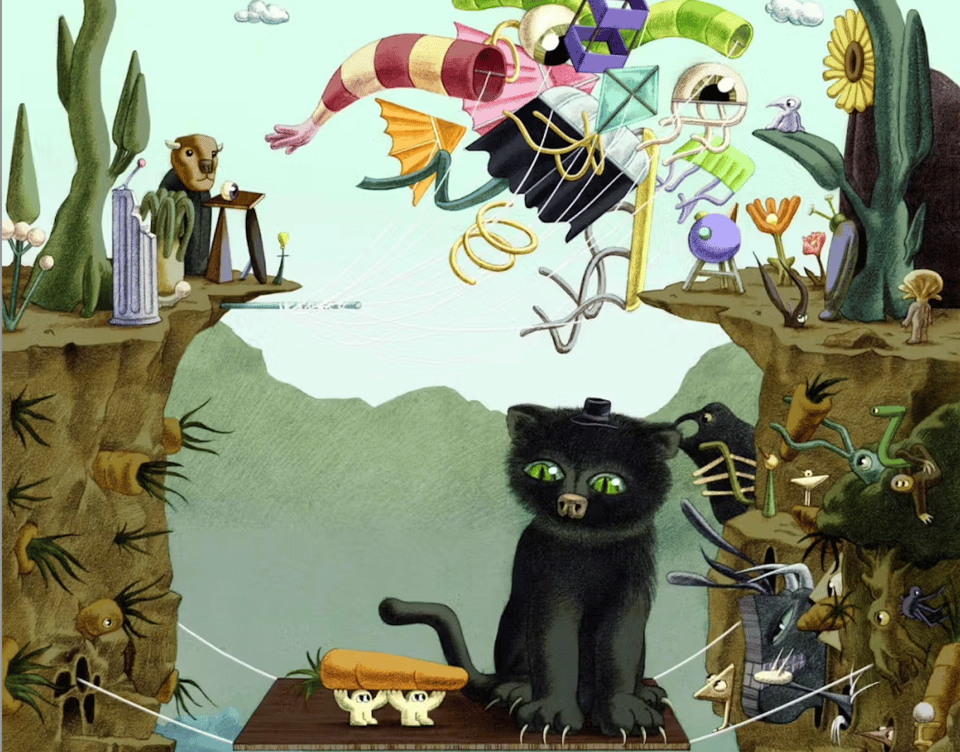
In the middle section, the little carrot guys are crossing a treacherous, precarious bridge, which is a visual metaphor for trying to post on legacy social media.
You make something you put your heart into and you want to share it with the people who actually care. And then you're just stuck on a rickety bridge, hoping your stuff makes it across and the algorithm doesn't decide your work isn't worth showing to people who explicitly asked to see it.
The cat represents the gatekeepers. It just sits there, controlling the bridge, mining everyone's attention while curators do all this precarious work building beautiful spaces and trying to reach their communities. They're so big they don't even have to try block the little carrot guys. Sitting there is enough to be in the way.
You should read the whole thing, it’s great.
Anyway, this got me to thinking about how optimistic I feel about social media when I’m on Bluesky — not in a weird, zealot-y, turning up at your door and asking to talk about our lord and saviour “decentralisation”, more in a “there’s something actually different going on here, and it might turn the tide for the better”. But, I’ll be honest, understanding what’s going on under the hood can be confusing and boring. So, most people don’t bother trying and I totally get why.
This week, Dan Abramov wrote a fantastic long essay called Open Social, which does a really good job of explaining what’s going on, but it’s still aimed fundamentally at a technical audience. So I’m challenging myself to try and articulate what I find hopeful about the current moment, in a way that a frat bro who can’t tie his own shoelaces could understand (see how that works better than saying “in a way your mother will understand”?).
The primary reason most people have given up on social media is that they have no way to control what they see. Even before Musk bought twitter and turned it into a nazi bar, users were railing against algorithmic feeds, longing for the old days of a simple timeline of people you’d chosen to follow. Instagram went the same way: instead of being photos posted by people you know, every third post was suggested, or an ad, or both. Tiktok is a firehose to the face. None of this is new, and we’ve hated it since facebook changed the feed settings like fifteen years ago.

So, yes, it’s nice to be on Bluesky and enjoy reverse chronology, but that’s not wild innovation. And it’s nice to block and mute people, and I do that with abandon (get thee gone, terfs) but again, not revolutionary. What is brand new is custom feeds. Making a feed for yourself means you get to be as specific as you like about what you see. Every photo of Harry Styles, every video of Evgeni Malkin, no mentions of US politics, every banger from @dril, no spoilers for Survivor, and so on and so on.
(Note: this isn’t a sales pitch for Graze because Graze is free so I can’t sell it to you, but it is a great way to make feeds)
When you start experiencing social media through a feed that you built, and you control, you start to remember what social media was like when it was good.
Plus, you don’t have to do all this work yourself — people are building and sharing feeds literally ALL the time, so you can just pick some you like (about cycling, or science, or lego) and follow those. Or you can copy their feed logic and remix it to make your own. Do whatever you like! That’s the whole point!
But it’s more than that.
Bluesky’s been taking some heat lately for some of its moderation decisions around political content (particularly surrounding Kirk’s murder), and for being quick to enforce age verification laws from the UK and some US states.
This prompted a lot of users to yelp that Bluesky was just the same as the bad place, that it couldn’t be trusted, same old walled gardens, blah blah blah. (aside: a lot of yelpers are people who think mastodon/fediverse/activitypub is the Right Answer and while I’m happy to explain why they’re not, we’re going to wind up right back in “confusing and boring” territory if I do, so let’s just say users who are not cishet white men have historically not had a good time over there and leave it at that).
Anyway, I’m huge proponent of active, human moderation. But at first glance this does seem a bit like old twitter, right? Like how can we trust Bluesky when they say they’re “billionaire proof” if they make decisions we don’t agree with but we have to abide by?
The simple answer is that we don’t have to abide by them.
Bluesky’s moderation decisions are client-side. They use something called a labeller, which is exactly what it sounds like. Posts can be labelled as offensive, or racist, or illegal, and hidden from view. Bluesky applies labels (hardcoded in the app — that’s their moderation). On top of this you can subscribe to labellers that other people make.
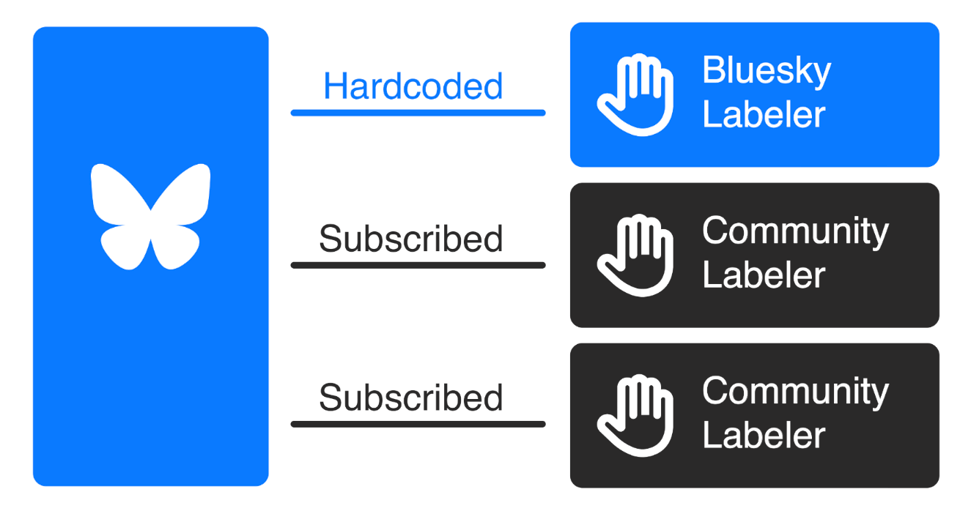
Labellers can be used for all kinds of things — like you can use a labeller to mark posts with medical misinformation, or to declare your favourite Taylor Swift era. But you can also subscribe to a community labeller that moderates, say, anti-trans content that you don’t want to see in your feed ever. So there’s true personal moderation possible on top of the base layer.
But what if you don’t agree with Bluesky’s hardcoded labels? Well, you’re free to leave. But here’s the great news about that.
Bluesky has built and exists on top of something called ATProtocol (or atproto). You do not need to know anything about that, really, but it is cool and if you’re curious, go back and read Abramov’s essay at the top.
The bit that’s worth understanding is that other people and companies can build whatever they like on atproto as well — not just Bluesky. At it’s simplest, that might just mean someone building an app to read bsky in a way that you like better than the official app (remember how we all liked our own versions of twitter apps back before twitter broke them — tweetbot, and twitterific and so on).
It might mean someone builds their own PDS: the data server where all your posts, likes, follows and personal information are stored. You might want to host your own PDS (probably not — if you were enough of a nerd to want that you wouldn’t be reading this). Or you might want to move to a PDS run by a community you trust.
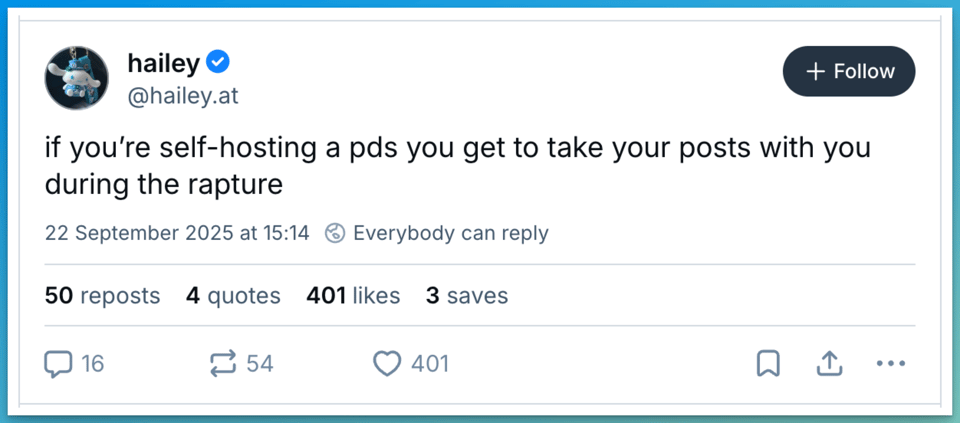
And when you go you take all your information with you. No, not like when you exported your twitter and were sent a useless spreadsheet full of your old tweets. Your whole history and network and likes and everything — you can just take that somewhere else on atproto and it will still work just the same as if nothing changed.
The biggest migration so far is by Black users moving from the Bluesky PDS to a new Blacksky PDS, where they can enjoy moderation and rules built by and for their community. Rudy Fraser’s recent convo with Rabble is a great watch about this.
Blacksky is the most advanced alternative so far, but others are following up including Northsky (creating a safer social media experience for 2SLGBTQIA+ people). Gander is about to launch, built and hosted in Canada.
And if you move and hate it? You can always go back.
I’ve referenced Rudy Fraser before referring to Bluesky as a skeuomorphism — the fact that it looks and feels a lot like twitter helps people to make the move across. It feels familiar. But if we stick with this way of thinking about it we’re falling victim to “horseless carriage syndrome” and not taking full advantage of everything this new infrastructure has to offer.
Once people understand that they can build pretty much anything on top of atproto, I think things are going to get delightful and different.
The best early example of this for me is Anisota from @dame.is. Dame was already my hero for creating the world's first decentralised toilet and a bespoke, hyper-niche social networking site called Flushes. No, really.

Anisota, on the other hand, is an entirely new way to consume social media. From dame:
At its core, anisota.net is an experimental social media interface and game for Bluesky and the AT Protocol. You don't "scroll" through an endless feed of posts. Instead, you flip through a finite deck of cards until you run out of stamina. You don't see engagement metrics front and center, instead each post has a "rarity" icon as if it were a trading card. You can collect post cards into curated decks that can then be shared with others. There are even in-game items, specimen collecting, and soon to be quests.
It's inspired by the last decade of my art practice, spiritual practice, and posting practice. It's "homegrown" in the mountains of Appalachia far away from silicon valley, startup culture, and whatever the hell they're doing at A16Z or Y Combinator.
My process involved sitting outside in my backyard at 1am observing moths. It looked like reading books on animals and anthropology instead of listening to podcasts about ARR and angel investors.
Amen.
When you run out of stamina you can’t keep flipping cards. It’s beautiful.
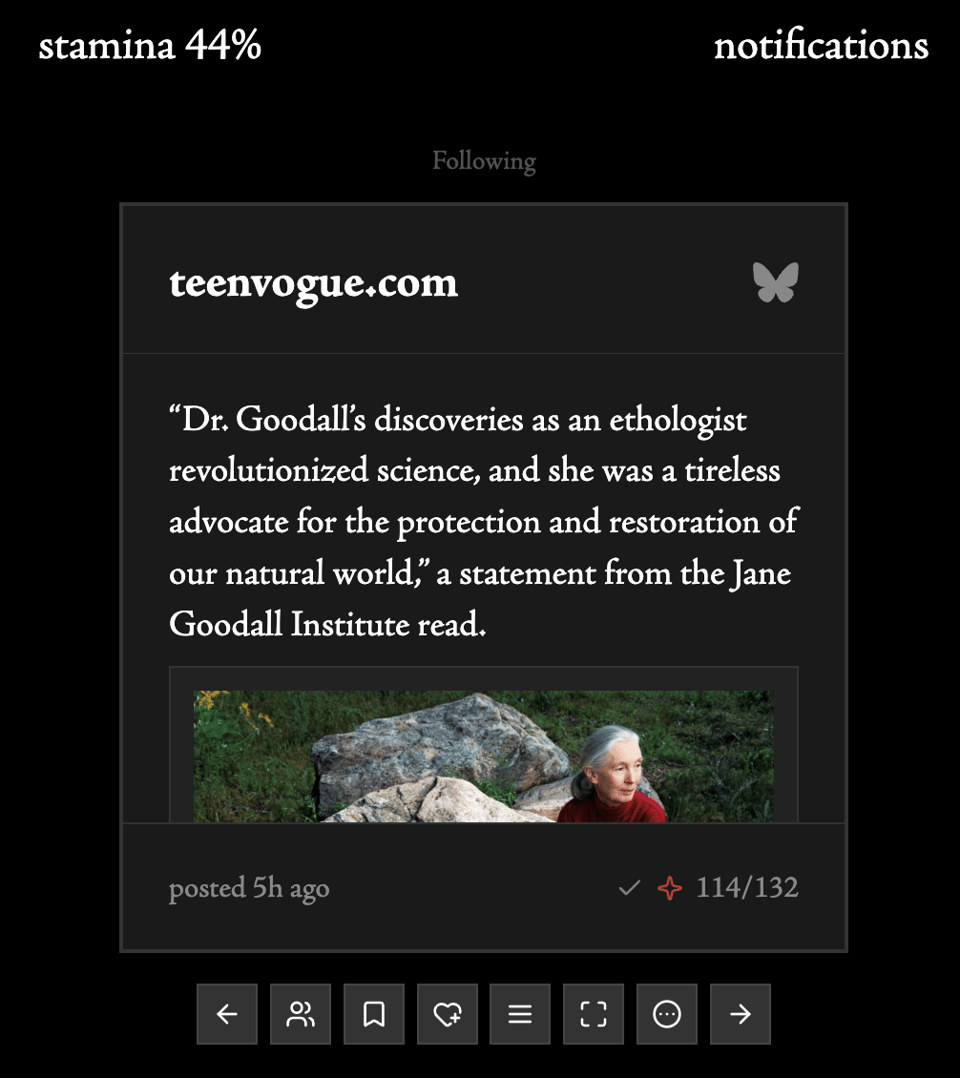
The point is, we’re only at the beginning of working out what next might look like. There are a ton of apps already built to do many of the things we already recognise (share photos, consume short video, chat with friends, plan events) and these are great and useful and get us outside the walled gardens, but I think we’re only going to unlock the full potential when we get weird and start building for ourselves again.
I don’t know if Bluesky or atproto will end up “winning.” But that’s not the point. The point is that for the first time in a long while I log on and feel possibility rather than doom. That tiny shift matters. It’s what keeps me tinkering, curating, writing, sharing. And it’s why Graze’s little carrot guys resonated with me so much this week: they’re not just inching across a precarious bridge, they’re also reminding us that we don’t have to keep crossing the same rickety structure forever. We can build something sturdier and stranger and more interesting and beautiful and flourishing on the other side.
this is good, on the rise of AI Chatbait:
Chatbots tend to be sycophantic: They often flatter and sweet-talk users in a way that encourages people to keep talking. But, in my experience, ChatGPT goes a step further, stringing users along with unrequited offers and provocative questions. When I told the chatbot I was thinking of getting a dog, it offered to make a “Dog Match Quiz 🐕✨” to help decide the perfect breed. Later, when I complimented ChatGPT’s emoji use, it volunteered to make me “a single ‘signature combo’ that sums up you in emoji form.” How could I decline that? (Mine, apparently, is 📚🤔🌍🍦🍫✍️🌙.)
via webcurios (hi Matt!), this is so cool. Dial a Poem.
“First launched in 1969 by poet John Giorno, Dial-A-Poem began as a radical experiment: pick up the phone, dial a number, and hear a poem. Today, it’s a global network. Working with partners around the world, Giorno Poetry Systems records contemporary poets reading in their native languages and makes their work available through freely accessible local phone numbers. This website brings together Giorno’s original recordings alongside those from each international edition in one accessible space. Click the phone to pick it up and hear a poem. Click again to hang up. Click again to hear another.”
Over at Naive Weekly, you can help out Tiffany N as she attempts to map the internet.
Three simple steps:
- Draw the internet as you imagine it to be today
- Indicate where “home” is on the map
- Send your submissions to tiffany@breakfastatmyhouse.com
Please take any and all creative liberty with this—submissions close by October 20th, 2025.
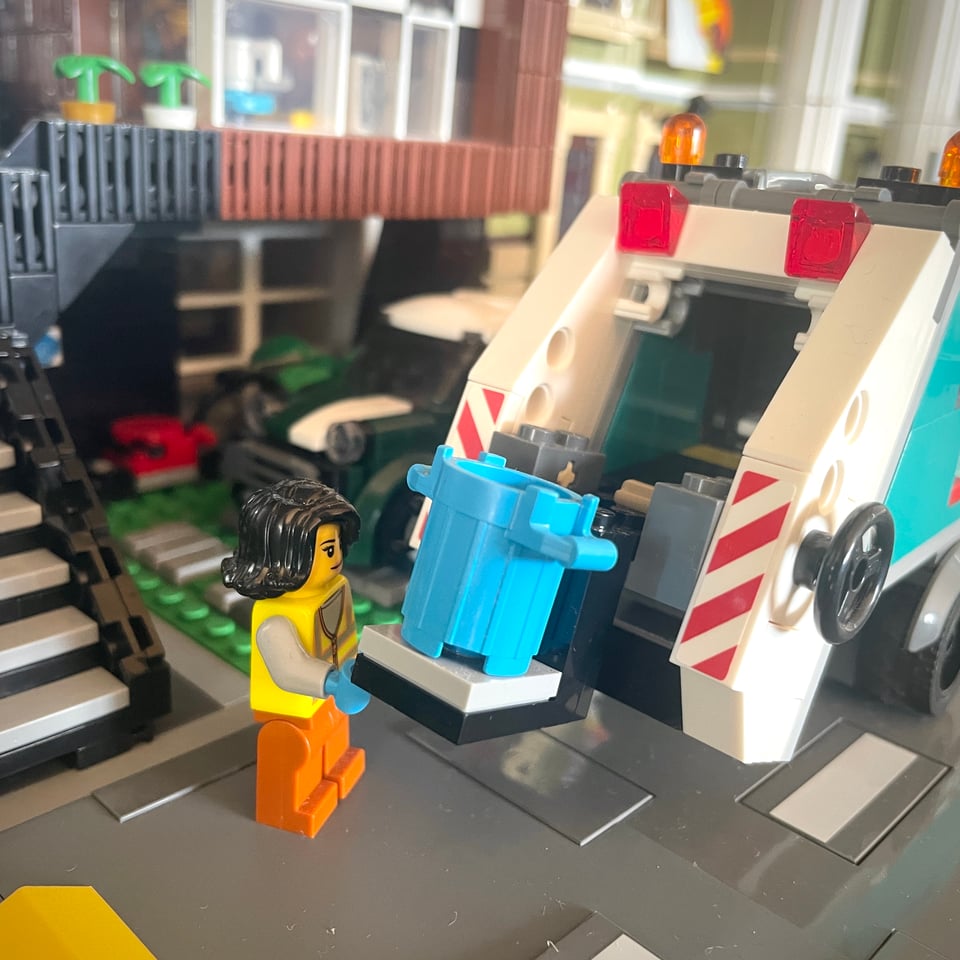
Forward this to someone who claims social media is beneath them.